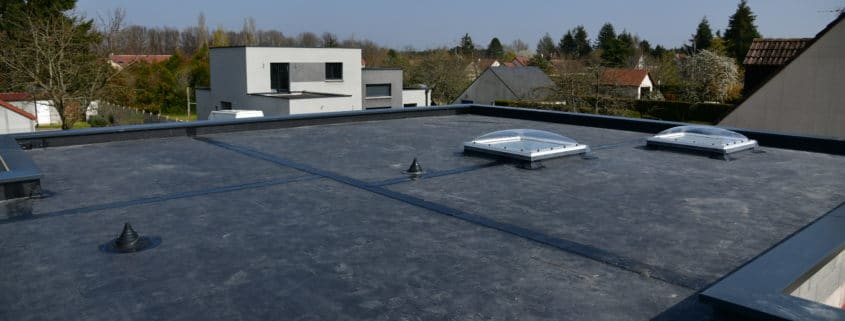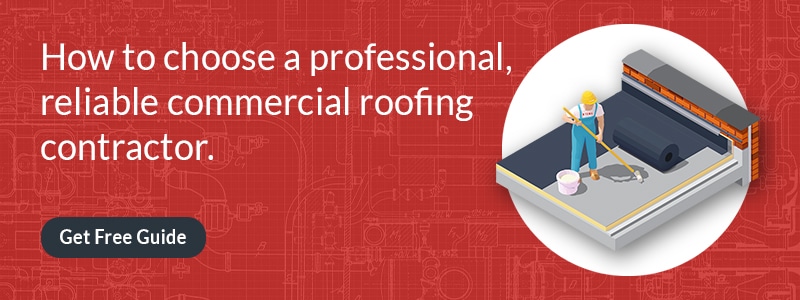The roofing system that’s covering your business is often taken for granted until something goes wrong and you’re tasked with repairing or replacing it altogether. When that time comes, though, you have a few important decisions to make, including what type of roof you want and what roofing materials are best.
Because a roof is such a lasting investment, you’ll want to talk to experts, and potentially do a bit of your own research before making any decisions, to ensure that what you end up with will suit your specific needs.
If you’re looking into commercial roof replacement or repair in northeast Ohio, TEMA Roofing is here to give you the confidence to know that you’re making the best decision for your business, whether you choose a metal roofing or a rubber roofing system.
In regard to commercial roofs, metal roofing and rubber roofing are two of the most common materials used. So, let’s take a moment to understand the advantages and disadvantages of both.
Metal Roofing for Commercial Buildings
Metal has historically been one of the most popular roofing materials for those seeking durability and longevity. Modern-day metal roofs can last upwards of 50 years when maintained properly and are appropriate for a wide variety of applications.
→ Download Our FREE Guide To Choosing a Commercial Roofing Contractor
Advantages of Metal Roofing
Metal roof systems are among the most reliable options for commercial roofing, especially in areas that experience powerful storms and high winds. Typical metal systems are comprised of a number of layers, including but not limited to the following:
- Edging
- Insulation
- Ventilation
- A water/vapor barrier
- Flashing
- The actual metal material being used for the roof
Whether you’re constructing a corrugated or standing seam metal roof, once the roof installation is complete, it should last a lifetime.
Another advantage of metal roofing is its reflective property. Metal roofs tend to reflect solar light and heat, which can increase your building’s energy efficiency and dramatically affect (in a good way) your cooling costs. They also won’t require the same regular maintenance costs (thanks to their durability), won’t corrode, are resistant to impact, and easily shed snow and ice thanks to the way metal paneling interlocks.
Disadvantages of Metal Roofing
Metal roof installation may take longer to install, repair or replace due to the complexity of the product. Cost per square foot for this type of roof are also typically more than that of a rubber roof for the same reasons.
Keep in mind, though, that the extra cost is an investment in its longevity, and you’ll likely have fewer repairs and replacements with a metal roof than with a rubber roof.
Another potential disadvantage is noise. Rain, hail, wind, and other abrasive storm factors may be much louder on a metal roof than on a rubber roof. While some businesses may not be affected by this kind of ambient noise, it can be very distracting to others. (For example, an industrial manufacturer may never notice the noise due to otherwise loud working conditions, while an office setting may be dramatically affected).
Rubber Roofing for Commercial Buildings
Rubber roofing–also known as membrane roofing–is a much newer concept that began to gain popularity over the past few decades (since the early 1960s). Today, it’s become a common choice for the commercial roofing industry (particularly EPDM and TPO roofs) thanks to its short installation times and easy repair and replacement.
Businesses that can’t afford to halt office activities for long periods of time frequently opt for a rubber roof. When installed correctly by a trusted commercial roofing contractor, a rubber roof can last a quarter-century or longer without sacrificing too much by way of durability. Rubber roofing is especially effective on low-slope or flat roofs.
Advantages of Rubber Roofing
Roofing systems that use rubber roof materials have quickly become the most popular alternative to metal roofs. Most membrane roofs utilize one layer and are easy to install and maintain.
This ease of repair (and replacement and maintenance), saves both time and material for the customer and the contractor. EPDM and TPO roofs are also built to withstand high winds, up to 140 MPH, and other weather phenomena. Additionally, they are resistant to cracking, splitting, and curling and hold up well against fire, hail and plant growth.
Rubber roofs have a similar lifespan to asphalt shingles, often lasting 20-30 years (or longer), depending on how well they are maintained. If this type of roofing system is installed correctly and regularly monitored for issues, rubber commercial roofing should last the majority of your career!
Disadvantages of Rubber Roofing
While rubber roofing materials are both convenient and reliable, they won’t be quite as durable as metal roofing in the face of vicious storms, large debris and other abrasive factors. You may encounter more frequent repairs (or the need for replacement) if you live in an area with regular wind, snow and ice storms.
However, as mentioned above, these repairs and replacements are often easy to complete and take less time and investment than those done on metal roofing.
You also need to be certain that the installers you choose have significant experience with rubber roofing. While many may claim to have the experience, it’s always wise to do your research and work with a trusted, professional commercial roofing company for installation. If the roofing is not laid correctly, there can be issues with leaking from the beginning. If done correctly, though, a rubber roof should be waterproof and last for decades.
Which Commercial Roof is Right for Your Roof Replacement?
If you’re looking for something both quick to install and reliable, a membrane (or EPDM/TPO roof) system will likely be more than enough to suit your needs.
However, if you have the time to invest in a more long-lasting solution, it may be worth looking into a metal roof.
Ultimately, the choice is yours, but if you’re still in the planning stages, our blog is a great resource in comparing roofing materials and options for installation. For commercial buildings in and around the Youngstown, Ohio area, both rubber roofing and metal roofing may be an appropriate option. We’d be happy to come assess your needs and provide a free quote for repair or replacement.
If you own a commercial space and are in need of a reliable commercial roofing partner, contact us today. We look forward to working with you!






